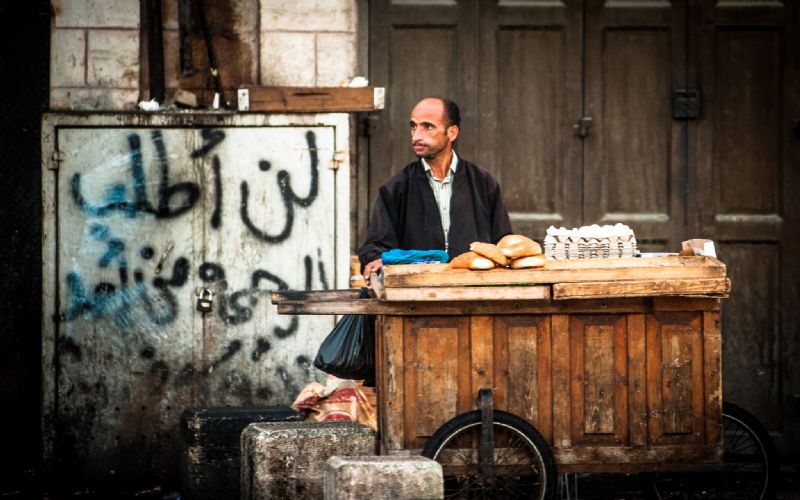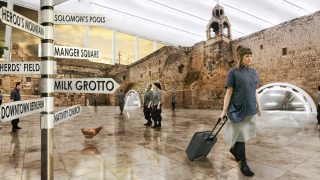Ibn Battuta, arguably the greatest medieval Muslim traveler, did not do Jerusalem justice when he reduced the bulk of his description of the city to the Dome of the Rock and Al Aqsa mosque in his seminal travel book, The Riḥlah. While he did mention different landmarks in other Palestinian towns such as the markets of Nablus and Ramla, he overlooked Jerusalem’s markets, whose vendors’ calls haven’t been muted since way before the Moroccan traveler’s days.
Jerusalem is not solely about the golden dome; rather, Jerusalem is mainly about its people, merchants and workers, whose presence in the city remains as commanding as that sacred spot. Those are the ones who bear the scars of Israel’s occupation of the city in 1967, and what the years of occupation have wrought ever since.
While it only occupies a square meter on the pavement, the vending cart simultaneously permeates an entire history shared by successive generations of Jerusalem’s families.
Jerusalem’s Palestinians have formed affection with those wooden carts and found in them an opening to make ends meet. Cart sellers and buyers alike are accustomed to the carts’ goods in their everyday commutes. But in the centre/periphery predicament constructed by the colonial power, the latter insists on eliminating street vendors under the pretexts that they disrupt the need for organizing the city and improve its civilized image. Concomitantly, the colonial power invests in the carts for economic profits and tourism, imposing an orientalist dominance that transmogrifies the carts into a mere scene stripped of its roots or context, thus erasing the Palestinian character of the Old City.
On the Backdrop of Taxes
The vending cart, or basta in Arabic, is one of the terms deeply entrenched in our everyday lexicon. Born out of our societies and their local economies, it is enough to follow its heavy presence in our vicinity to trace its roots, both historically and linguistically.
The word “basta” is derived from the verb “basata” or stretched on a surface, but it surely is related to “bassit,” Arabic for simple, due to the modesty of the commodities sold by its owners. Those commodities are common for daily consumption and do not need significant capital or complex equipment to prepare them. You will often see Jerusalem’s cart sellers sell popular beverages such as almond milk, tamarind juice and cumin, and traditional food such as barbeque, falafel, corn on the cob, sweets, and the famous Jerusalem ka’ak, the bread rings sprinkled with sesame seeds.
Present, too, are the female peasants who come to Jerusalem from the West Bank countryside to sell their fresh vegetables. They are the produce of the surviving traditional Palestinian agriculture after Israel had decimated the majority of agricultural lands in that area and after the vegetables grown in Israeli greenhouses had come to dominate the Palestinian market in Jerusalem.
What distinguish the commodities offered by cart sellers within the Palestinian society in Jerusalem is their significantly lower prices in relation to the commodities sold in the Israeli market, which has to do with the income disparities among Palestinians and Israelis in the occupied city.
Historically, vending carts and poverty have always been symbiotic as far as vendors and consumers are concerned: marginalized classes seek a refuge in the cart and so do the poor who cannot shoulder the burden of opening or renting a shop of their own inside a building. But in a city like Jerusalem, where indigenous Palestinians are struggling to buy or own a home for living, talking about renting a shop becomes a luxury.
This is the case because, in addition to paying high rent, they have to pay numerous costly taxes such as the property tax, which is collected according to the size of the apartments and the shops and is imposed in varied values. Israeli occupation authorities have used this tax as means to exert pressure on Jerusalem’s Palestinians. Taxes imposed on some Palestinian shops in the Old City have reached millions of New Israeli Shekels. This forced about 25 per cent of the overall number of Palestinian shops in the Old City to close down by 2012.
In an attempt at evading the stronghold of taxes on the one hand and the high rent on the other, many have found in the carts a source of livelihood for them and their families, but they were thwarted by regulations that turn them into offenders in the alleys of their own city.
A Real Face or a Mask?
A peasant dressed in an embroidered dress collects, with the help of some youth gathering around her, the figs thrown on the ground by the Jerusalem Municipality’s inspectors in a routine inspection procedure carried out “in accordance with their duty.” Other cart sellers were more fortunate than her and managed to run away with their goods in the usual cat-and-mouse “game” they “play” with the inspectors. The latter can be seen regularly roaming around the alleys of the Old City wearing their black outfits and sunglasses, threatening to fine the street vendors under the pretext that they had violated the municipal regulations applicable to peddlers in the city. The regulations require the acquisition of a license from the Jerusalem Municipality in order to peddle on the streets.
Occasionally, some municipal inspectors issue the fines or overturn the cart before heading to Al Aqsa mosque to pray. “Some of them are Palestinians like us,” one peasant told me, before adding, as if trying to grasp what exactly those “Palestinians like us” share with us: “He would do us a favor if he were to throw the goods on the ground instead of confiscating them: if he threw them, we could collect the undamaged stuff and sell it; but expropriation means that an entire week’s toil has gone in vain.”
The regulations of street businesses imposed on Jerusalem’s Palestinian cart sellers may resemble laws in countries that have joined or bidding to join the parade of modernity. Among those countries is post-revolution Egypt, which enacted Law 105/2012, designed to drive streets vendors away from the Iconic Tahrir Square by increasing punitive measures against them, including raising fines and prison sentences for unlicensed peddling.
But what ostensibly seeks to regulate public space in Jerusalem is in fact used by Jerusalem Municipality as a tool to alter the features of the Old City in particular, and the city in general, under the guise of improving its appearance and preserving its modernity and neatness. Such euphemisms carry an exclusionary dimension because they presuppose the existence of strange individuals and groups that must be expelled from the desired social and political order, a process referred to by Polish sociologist Zygmont Bauman as the obsession with order.
The colonial obsession in Jerusalem manifests itself in the constant pursuit of appropriating the public space and stripping it of its Palestinian character. This is particularly true in the Old City because of the history and deep-rootedness it subsumes and which, until this day, saturate the buildings and social heritage of the city.
The process of exclusion follows a simple logic: the regulations stipulate acquiring a permit from Jerusalem Municipality in order to open a cart, while the municipality systematically rejects granting such permits. Thus, street vendors are forced to peddle without license which costs them huge fines. This is an extension of the very logic of the obsession with order which turns law into a tool for exclusion that criminalizes the excluded and blames them for violating the law, subsequently requiring their punishment.
Over the past few decades, Jerusalem Municipality has fined street vendors with sums that they cannot even imagine, racking up at times an accumulated 50,000 or even 80,000 shekels per individual (or what accounts to $23.000).
A persevering street vendor, who has been selling his sweets for 40 years in this same alley, tells us that fines have increased consistently over the years, climbing from 30 shekels ($7) for each inspection to 475 shekels (nearly $135), which the vendors are forced to pay on multiple payments. Meanwhile, those who cannot pay the fines might find themselves in jail. Zaki Sabbah, a street vendor of sesame cake, has faced a total of 284 tickets which he couldn’t afford to pay and was originally sentenced by an Israeli court to ten years in prison. To get an idea about the misery endured by those street vendors, one needs look no further than to the price of one sesame cake which is sold for less than $1, and might hit the $1 if bought in addition to a boiled egg.
“Yalla basta”
Noting the etymology of the word “basta” earlier did not come as coincidence or a fleeting remark, but as an introduction to a context in which colonialism competes with the cart not only over the stage that it occupies, but over its name as well..
For instance, an Israeli private company bestowed the name “Yalla Basta” on a campaign to market tickets with attractive prices that grant their purchasers the excellent experience of tasting the cuisine of the Old City. Posters including the Arabic headline of the campaign printed in Hebrew letters were hanged on shops and carts in the Old City to guide the visiting tourists to their spots.
To promote itself, the campaign calls on Israeli tourists to “live the experience of the souk as if they belonged to the place.”
The contradiction that seemingly exists between investing in and promoting tourism in the Old City on the one hand, and the ongoing suffocation of cart sellers and shop owners in the very same place on the other hand, is the most striking evidence that Jerusalem cannot be viewed in black and white.
The Old City is the most significant and strategic site in the city – historically, economically and politically. Despite the smothering colonial reality that aims to drive Palestinians out of the Old City in particular, and Jerusalem in general, it’s Palestinians – their identity and their character – that command the most powerful presence in the public space. For Palestinians, the Old City is not a place they tour for fun; rather, it is the source of their livelihood and the place of their residence that provides all the necessary conditions for their living. They persist in this place and do not leave it, rebuilding the houses that Israel demolishes, and peddling on the streets again and again despite repeated fines.
Israelis, though, are but tourists, and the Old City does not constitute the epicenter of their daily lives. Thus, they realized the need to establish an orientalist dominance that manipulates the identity of the place and re-fashions reality on the ground to turn Palestinians into trespassers who must be cast aside.
Government-sponsored and private tourism work hand-in-hand to appropriate the Palestinian public space in the city, transfigure its identity, and turn it into scenery where the native Palestinians operate as exotic landmarks to please the tourists and raise Israel’s tourism revenues. In the meantime, Palestinians are impoverished and prevented from developing their space or dwelling in it in dignity.
Jerusalem Municipality regularly organizes festivals in the Old City such as the Light Festival, a festival of music and dancing held annually in June, transforming the Old City and its walls into a theatre for boisterous events. Palestinians, meanwhile, are banned from holding public events in the Old City and such activities, if carried out, are dispersed with force and intimidation. Thus, Palestinians are marginalized and deemed invisible because they are deprived of the chance to influence the public space shaped by the Old City. Jerusalem’s Palestinians are not allowed to build or develop projects within their own public space. To make matters worse, most Palestinians from the West Bank and the Gaza strip are no longer part of this public space, even though their footsteps remain etched into its every corner thanks to ages of company.
Israeli tourism initiatives call on Israelis to flock to the Old City, making it part and parcel of their daily reality in the “unified city” to impose their presence at the expense of Palestinians and feel like the sons and masters of the place. In one instance, you see an Israeli pat a child selling pomegranate juice on the back simply because he speaks some Hebrew. In another, an Israeli takes picture of himself standing next to a ka’ak cart, while the cart seller’s eye turns to the left in fear of an inspector threatening to enforce his law, laws that treat everyone equally. Do they?







